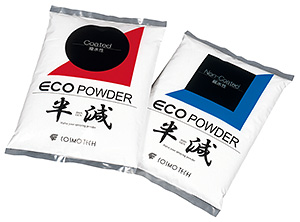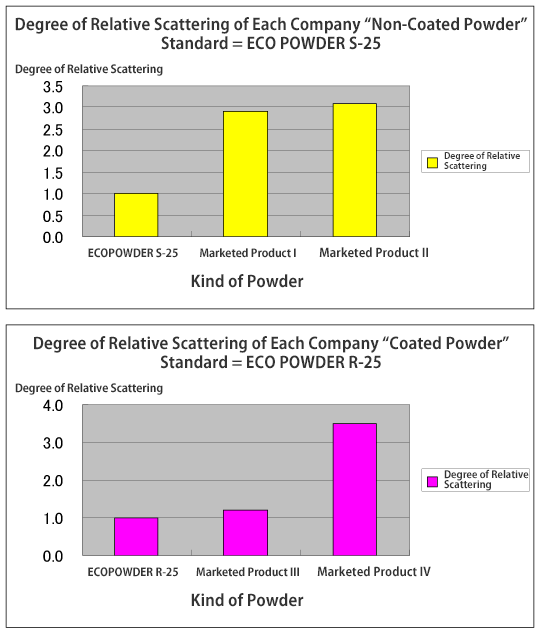ECO POWDER HANGEN

Halve Powder Consumption
| Coated R-25 | Non-coated S-25 |
| Coated R-35 | Non-coated S-35 |
| Non-coated S-45 |
![]()
It is powder more environment-friendly than others.
Scattering is less than others and it is safe for the body.
Features
- The main ingredients of powder are using vegetable starch.
- Since it is made of a safe ingredient even if powder is inhaled accidentally or it goes into a mouth, it can be used in comfort.
- There is little generating of static electricity and uniform equal spraying is possible.
- Only uniform grains are carefully selected to prevent blocking and ink set-off at the least amount.
- Minimize accumulated powder on equipment by less scattering or dispersion.
- Smoothen the surface of printed sheets
- Less maintenance for blanket cylinders
ECO POWDER is recommended to use with our powder spraying system CHP-3/ CHP-21 for better results.
By combined use with CHP-3/CHP-21, an average of 50% reduction of the amount of the powder used is possible.
ECO POWDER PRODUCT LIST
| Type | Item No. | Particle (µm) | Application | |
|---|---|---|---|---|
| Modal Diameter *1 | Half Width *2 | |||
| Non-coated | S-25 | Approx. 16 | Approx. 13~28 | Normal Thin Paper |
| S-35 | Approx. 19 | Approx. 13~31 | Normal/ Heavy | |
| S-45 | Approx. 24.5 | Approx. 15~40 | Heavy Paper | |
| Coated | R-25 | Approx. 18 | Approx. 13~28 | Normal/ Film |
| R-35 | Approx. 19 | Approx. 13~33 | Normal/ Heavy | |

As the powder is derived from natural starch, the particle size may vary on original of the material and climate changes.
*1・・・The highest particle diameter of particle size distribution (%)
*2・・・Width of the particle diameter indicating half values of mode diameter
Safety of ECO Powder
Vegetable starch: Raw material
- Dust explosion…Unless explosion 3 conditions (particulate fate concentration, the amount of oxygen, the source of ignition) are met, explosion does not occur.
- U.N. classification…Non-dangerous object
- A risk of receiving the human body of WHO/IARC (external organization of International Agency for Research on Cancer and WHO)…
No carcinogenic risk
No risk of a black lung - The U.S. Occupational Safety and Health Administration (OSHA) permissible exposure limit (PEL) … 15mg/m3
- American-Conference-of-Governmental-Industrial-Hygienists (ACGIH) allowable limit (TLV) … 10mg/m3
- A Japanese industrial health community and exposure limit: Second Class particulates acceptable concentration … (Inspiratory) 1mg/m3
(Total particulates) 4mg/m3
Dispersing agent: Additive agent
- Major application … A food additive, nutritional enhancement minerals, yeast food, gum base, emulsifier
- Evaluation of Joint FAO/WHO Expert Committee on Food Additives (JECFA) … A (1)
*A (1) ・・・That to which evaluation of JECFA was completed and acceptable daily intake was set.
Or the thing by which the setup was made unnecessary on toxicity. - JECFA maximum tolerant daily intake (MTDI) ・・・ 70mg/ body weight per day
- Dangerous toxic classification (Japanese standard of classification) … It does not correspond to a standard of classification.
- Acute Oral Toxicity of a rat (LD50:50% fatal dose) … > 1,000mg/ body weight
- ACGIH … Un-corresponding.
- A Japanese industrial health community indicator and exposure limit Third class particulates Acceptable concentration … (Inspiratory) 2mg/m3 (Total particulates) 8mg/m3
Water repellent material: Add only to an additive agent and water-repellent powder.
- Major application … A food container packing filler, a reinforcing filler, a distributed auxiliary agent, a coating flux, a corrosion-proof auxiliary agent, a fluid improvement, the thickening agent of printer’s ink, an anti-settling agent, electrification stabilizer
- Classification of dangerous hazardous property … It does not correspond to a standard of classification.
- Japan Hygienic Olefin And Styrene Plastics Association … Positive list registration (term of validity: 2016)
- Europe hazardous substance instructions and correction/ adaptation matter … A non-hazardous substance
- International shipment regulation … Un-dangerous goods
- ACGIH-TLV … 10mg/m3
- The maximum permission work place concentration (MAK value) … 4mg/m3
- A Japanese industrial health community indicator and exposure limit Third class particulates Acceptable concentration … (Inspiratory) 2mg/m3
(Total particulates) 8mg/m3 - Acute Oral Toxicity of a rat (LD50:50% fatal dose) … > 5,000mg/ body weight
- Animal experiment result …
The toxicity by repeated dose is not found.
Mutagenicity and carcinogenicity are not found.
Reproductive and developmental toxicity is not found. - Influence on a human body・・・
An experiment cooperator is medicated 60~100g/ day for 3~4 weeks. No harmful action. No report of oral toxicity.
No example of a black lung by the monitor result over about ten years of 200 or more water repellent material producers.
Sensitization actions (respiratory-organs hypersensitivity, superfluous immunoreaction of the skin, etc.) are not found.





